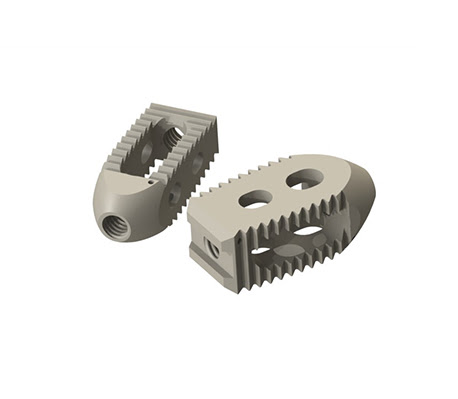E-mail iNfo@virkortho.shop Number +92-300-7477492

PLIF Cage
PLIF Cage Introduction
When it comes to treating lumbar spinal problems and ensuring effective fusion, the PLIF cage has shown to be an invaluable instrument.
A PLIF (Posterior Lumbar Interbody Fusion) cage is a medical device used in spinal fusion surgery to treat disorders affecting the lumbar spine. It is a device that is placed into the disc space between two neighbouring vertebrae from the back.
It is intended to restore disc height, provide stability, and encourage vertebral fusion.
PLIF Cage Sizes
The PLIF cage is a small, hollow device made of various materials such as titanium or polyetheretherketone (PEEK). PLIF cages come in a variety of shapes and sizes to meet the demands of the patient.
Titanium Mesh Cage are available in various diameters and lengths.
Diameters: 8mm, 10mm, 12mm, 14mm and 16mm.
Lengths: 20mm, 24mm, 28mm and 32mm
Width: 10mm
During a PLIF procedure, the surgeon gains access to the spine by making a back incision. To reveal the spinal canal and nerve roots, the lamina (the bony arch of the vertebra) is partially removed. After that, the injured intervertebral disc is removed, making room for the PLIF cage.
The PLIF cage is placed in the open disc space. It can have a variety of structures, but it is often a hollow or porous device with a central channel. The cage functions as a spacer, preserving correct disc height and restoring vertebral alignment. It also serves as a platform for the placement of bone transplant material.
PLIF Cage acts as a spacer, maintaining the disc height and restoring alignment between the vertebrae. It provides a stable environment for bone graft material to be placed, promoting fusion between the adjacent vertebrae. The fusion process involves the bone graft material growing and fusing with the adjacent vertebral bone, creating a solid, stable fusion mass.
Bone graft material can be taken from the patient’s own body (autograft) or received from a donor (allograft). The bone graft is wrapped around the PLIF cage and encourages the formation of new bone. This causes fusion of the vertebrae over time, resulting in a solid mass that stabilises the spine.
PLIF Cage Advantage
There are various advantages to using a PLIF cage in spinal fusion surgery. It aids in the restoration of disc height, relieves nerve pressure, stabilises the spine, and promotes vertebral fusion. The type of PLIF cage utilised will depend on the surgeon’s preference, the patient’s condition, and other considerations.
Stabilization: The PLIF cage helps restore and maintain good spinal alignment by filling the intervertebral space, providing stability and minimising pain caused by aberrant motion.
Load Distribution: The cage facilitates in the distribution of load and stress over the fused segment, reducing undue strain on surrounding structures.
Increased Fusion Rates: When compared to alternative fusion procedures, the use of a PLIF cage has been associated with better fusion rates, enhancing the likelihood of successful fusion and long-term stability.
Background: Posterior fusion procedures (posterior lumbar interbody fusion, PLIF; transforaminal lumbar interbody fusion, TLIF) are long-established surgical techniques for lumbar interbody fusion. They differ from anterior lumbar interbody fusion (ALIF) and extreme lateral interbody fusion (XLIF) procedures by approach and associated complications.
Objectives: The posterior fusion procedures PLIF and TLIF are presented and compared with other fusion methods, including advantages and disadvantages. Furthermore, the surgical technique and their complications are described. Based on the current literature, it is discussed which surgical techniques can be used in various cases.
Results: PLIF and TLIF procedures reduced back and leg pain, restored the sagittal profile of the lumbar spine, and achieved good fusion rates and long-term stability. Advantages of the TLIF procedure include shorter operative times, less blood loss, less intraoperative risk of injury to neural structures, and shorter convalescence. Compared with the interposition of a cage in the ALIF technique, a further step with the risk of vascular injury is eliminated.
Conclusions: The PLIF and TLIF procedures are almost equivalent posterior fusion procedures with high fusion rates, good long-term clinical outcomes, and low risk of complications. The TLIF procedure is slightly advantageous: lower nerve irritation rates, shorter operative times, and less extensive operation. Thus, the TLIF procedure is available for cases with single-sided pathologies and the PLIF procedure is available for bilateral compressions.
About
Exceptional orthopedic instruments and implants from Pakistan.
Contact
Portfolio
© 2025 All rights reserved.
Location
Quick Link